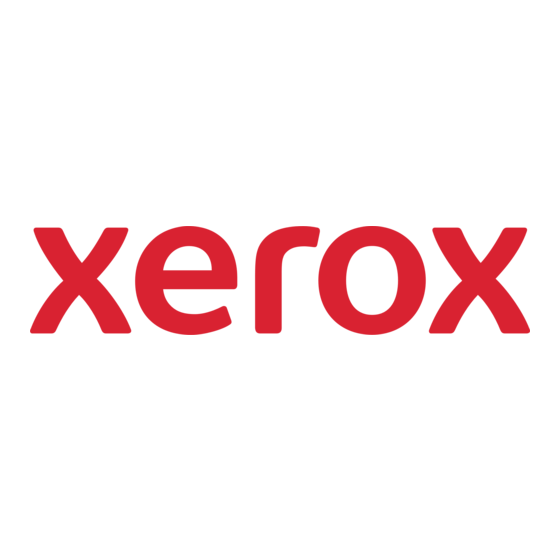Xerox ColorQube 9203 안전한 설치 및 운영 - 페이지 4
{카테고리_이름} Xerox ColorQube 9203에 대한 안전한 설치 및 운영을 온라인으로 검색하거나 PDF를 다운로드하세요. Xerox ColorQube 9203 12 페이지. Mfp
Xerox ColorQube 9203에 대해서도 마찬가지입니다: 설치 및 작동 지침 (14 페이지), 평가자 매뉴얼 (28 페이지), 빠른 사용 설명서 (38 페이지), 빠른 매뉴얼 (8 페이지), 빠른 매뉴얼 (16 페이지), 빠른 매뉴얼 (33 페이지), 안전한 설치 및 운영 (12 페이지), 사본을 만드는 방법 (9 페이지)

There are no new or unaccounted for Dynamic Loadable Modules (DLMs) or other software running on the
•
machine.
There are no active processes that access the hard disk drive(s).
•
No user is logged into a session via network accounting, Xerox Standard Accounting, or the internal auditron, or
•
into a session accessing a directory on the hard disk drive(s)
After a power on of the machine all subsystems must be properly synced and, if printing of Configuration Reports is
•
enabled on the device, the Configuration Report must have printed.
For any previously initiated On Demand Image Overwrite request the confirmation sheet must have printed.
•
The Embedded Fax card must have the correct software version and must be properly configured.
•
When invoked from the Web UI the status of the completed On Demand Image Overwrite will not appear on the Local
•
UI but can be ascertained from the On Demand Overwrite Confirmation Report that is printed after the Network
Controller reboots.
If an On Demand Image Overwrite fails to complete because of an error or system crash, Xerox recommends that first a
•
system reboot or software reset be initiated by the System Administrator from either the Local UI or the Web UI and be
allowed to complete; otherwise, the Local UI may become unavailable. If the Local UI does become unavailable the
machine will have to be powered off and then powered on again to allow the system to properly resynchronize. Once
the system reboots or software reset has completed the System Administrator should immediately perform another On
Demand Image Overwrite.
If there is a failure in the hard disk drive(s) a message recommending that an On Demand Image Overwrite be run will
•
appear on the Local UI screen. An Immediate Image Overwrite Error Sheet will also be printed or may contain
incomplete status information. The System Administrator should immediately perform the requested On Demand
Image Overwrite.
The time shown on the On Demand Overwrite progress screen displayed on the Local UI may not reflect Daylight
•
Savings Time.
If an On Demand Image Overwrite is successfully completed, the completion (finish) time shown on the printed On
•
Demand Overwrite Confirmation Report will be the time that the system shuts down.
The System Administrator should perform an On Demand Image Overwrite immediately before the device is
•
decommissioned, returned, sold or disposed of.
j). The device supports the use of SSLv2.0, SSLv3.0, RC4 and MD5. However, customers are advised to set the cyrpto policy of
their clients to request either SSLv3.1 or TLSv1.0 and to disallow the use of RC4 and MD5.
k). For SSL to work properly the machine must be assigned a valid, fully qualified machine name and domain. To set the
machine name and domain:
Follow the "Access Internet Services" instructions on page 2-6 of the SAG to access the Web UI.
•
At the Web UI, select the Properties tab.
•
Select the following entries from the Properties 'Content menu': Connectivity
•
Enter the domain name in the 'Domain Name' text box and the machine name in the 'Host Name' text box inside the
•
General group box.
Select the [Apply] button to save the domain and host names entered.
•
l).
Xerox recommends the following when utilizing Secure Sockets Layer (SSL):
Any self-signed digital certificate or digital certificate signed by a Trusted Certificate Authority should have a maximum
•
validity of 180 days.
If a self-signed certificate is to be used the generic Xerox root CA certificate should be downloaded from the device and
•
installed in the certificate store of the user's browser.
m). Xerox recommends that HTTPS be enabled in the evaluated configuration. To enable HTTPS (SSL):
At the Web UI
•
Follow the "Machine Digital Certificate Management" instructions starting on page 8-9 of the SAG to install on the
•
device either a self-signed digital certificate or a digital certificate signed by a Certificate Authority (CA).
Select the following entries from the Properties 'Content menu': Connectivity
•
5
From here on the directions assume that the Web UI has been accessed already by following the "Access Internet Services" instructions on page
2-6 of the SAG.
5
, select the Properties tab.
3
.
Protocols
Protocols
IP.(Internet Protocol)
HTTP.
3
